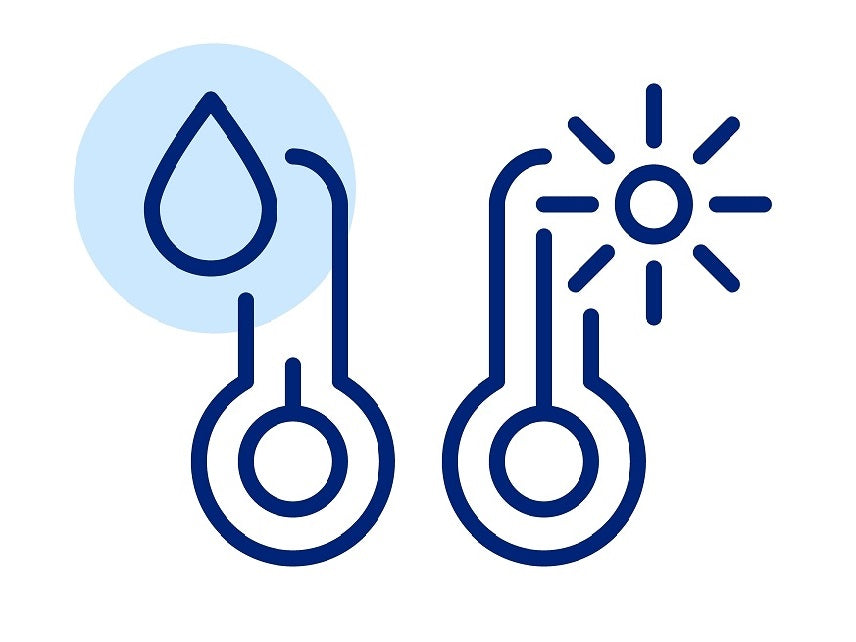Free U.S. Shipping On Orders Over $150

Dry vs. Humid Heat: What's The Difference and Why Does It Matter?
Posted on
This summer has been a hot one for the United States with certain places experiencing record-breaking heat waves. But the sweltering heat doesn't feel the same everywhere. Depending on how humid a place is, you might simply feel hot or experience a hellish sweaty, damp and sticky heat.
In this post, we discuss the differences between dry and humid heat and why it matters which one you are in. We also have some tips on how to handle each including how to dress, how to sleep comfortably and how to stay safe.
How Does Humidity Affect Heat? Dry vs. Humid Heat
The humidity level greatly affects how you perceive hot weather. The temperature could be exactly the same but how you experience it is totally different. That’s because humidity affects how easily sweat evaporates from your skin, which in turn affects your body’s ability to stay cool.
In extreme cases, this can actually be a life and death matter. If you cannot cool down, you can experience heat exhaustion, heatstroke and other life-threatening health effects.
Dry Heat
Dry heat occurs when there’s a combination of high temperatures and low humidity. Dry heat is common in states like Nevada, California, Texas and Utah.
While it sounds bad, dry heat is actually more tolerable compared to humid heat. That’s because sweat evaporates quickly in dry air. So your body has an easy time staying cool.
Of course, prolonged exposure to extreme dry heat can still cause heat-related health issues. But dry heat is generally less dangerous and easier to manage than humid heat.
Humid Heat
Humid heat occurs when there’s a combination of high temperatures and high humidity. This is the kind of heat you are likely to experience in places like Florida, Mississippi and Louisiana.
Humid heat feels damp, sticky and downright oppressive. It also feels hotter than dry heat even at the same temperature. That’s because the higher moisture content in air makes it harder for sweat to evaporate off your skin. And when sweat cannot evaporate, you don't get cooler.
So you end up sweating more but all the sweat just drips down your skin and soaks your clothes.
Humid heat is dangerous. Prolonged exposure has some pretty serious health impacts and could even be lethal if it’s too hot and humid.
Humid heat is one of the biggest climate change risks humans face. One of the reasons it’s so dangerous is because it is difficult to manage. The human body has not evolved to deal with extreme humid heat.
Humid heat is measured using wet bulb temperature. This is an actual representation of how hot it feels.
How to Stay Safe and Comfortable in Humid Heat
- It’s easy to get dehydrated in humid heat since you sweat a lot as your body tries to cool down. So remember to drink lots of water especially when you are outdoors.
- Be careful about exerting yourself too much when outdoors. Exercise makes you hotter, making your body struggle even more to stay cool. Above a wet bulb temperature of 82F, cut down on intense exercise. Above 88F, avoid any kind of exercise completely.
- Wear loose, light and breathable clothes to improve sweat evaporation. Natural fabrics like wool, silk, bamboo and linen are great because they are cool and wick sweat away from your skin. Avoid cotton since it holds onto moisture and can make you more uncomfortable.
- Lightweight synthetics like polyester and nylon are also great for humid heat since they dry quickly, so you don't end up with sweat soaked clothes.
- Take frequent breaks and spend most of your time indoors. This is especially important for vulnerable people like kids, pregnant women and the elderly.
- Use linen, silk, wool, bamboo, down or Tencel bedding. These materials have excellent breathability and they also wick away sweat. Avoid heavy cotton sheets as they can feel hot and clammy in humid heat. Polyester and microfiber bedding is also a big no-no.
How to Stay Comfortable in Dry Heat
Dry heat is a lot easier to manage since your body doesn't struggle to stay cool.
- Wear loose, light and breathable clothing to help your body stay cool. Again, natural fabrics are excellent. This includes cotton. In dry heat, the moisture-retaining tendency of cotton comes in handy. As sweat evaporates slowly from the cotton material, it keeps your body cooler for longer.
- Synthetic fabrics are also good especially if you will be active. But make sure they are lightweight and well ventilated. Anything too thick will overheat you and prevent sweat on your skin from evaporating.
- Drink plenty of water to stay hydrated. This allows your body to keep sweating without risking dehydration. To help with cooling, apply moisture on your skin using a sponge, cloth or spray.
- As temperature increases, reduce exercise and limit how much time you spend outdoors.
- Use light and breathable bedding made from cotton, bamboo, wool, silk, or linen to stay cool and sweat-free at night.
Quick links
Contact
6063 Hudson Road #160
Woodbury, MN 55125
Yo@hercLeon.com
Leave a comment: